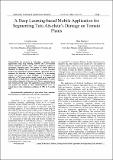| dc.contributor.author | Loyani, Loyani | |
| dc.contributor.author | Machuve, Dina | |
| dc.date.accessioned | 2022-09-15T06:43:21Z | |
| dc.date.available | 2022-09-15T06:43:21Z | |
| dc.date.issued | 2021-10 | |
| dc.identifier.uri | https://doi.org/10.48084/etasr.4355 | |
| dc.identifier.uri | https://dspace.nm-aist.ac.tz/handle/20.500.12479/1618 | |
| dc.description | This research article was published by Engineering, Technology & Applied Science Research, Volume: 11, Issue: 5, October 2021 | en_US |
| dc.description.abstract | With the advances in technology, computer vision applications using deep learning methods like Convolutional Neural Networks (CNNs) have been extensively applied in agriculture. Deploying these CNN models on mobile phones is beneficial in making them accessible to everyone, especially farmers and agricultural extension officers. This paper aims to automate the detection of damages caused by a devastating tomato pest known as Tuta Absoluta. To accomplish this objective, a CNN segmentation model trained on a tomato leaf image dataset is deployed on a smartphone application for early and real-time diagnosis of the pest and effective management at early tomato growth stages. The application can precisely detect and segment the shapes of Tuta Absoluta-infected areas on tomato leaves with a minimum confidence of 70% in 5 seconds only. | en_US |
| dc.language.iso | en | en_US |
| dc.publisher | Engineering, Technology & Applied Science Research | en_US |
| dc.subject | Mobile applications for agriculture | en_US |
| dc.subject | Tuta Absoluta | en_US |
| dc.subject | Deep learning | en_US |
| dc.subject | Convolutional neural networks | en_US |
| dc.title | A Deep Learning-based Mobile Application for Segmenting Tuta Absoluta’s Damage on Tomato Plants | en_US |
| dc.type | Article | en_US |

